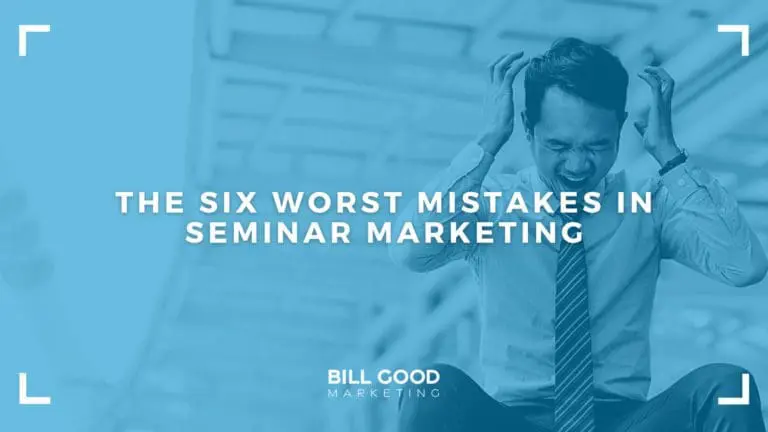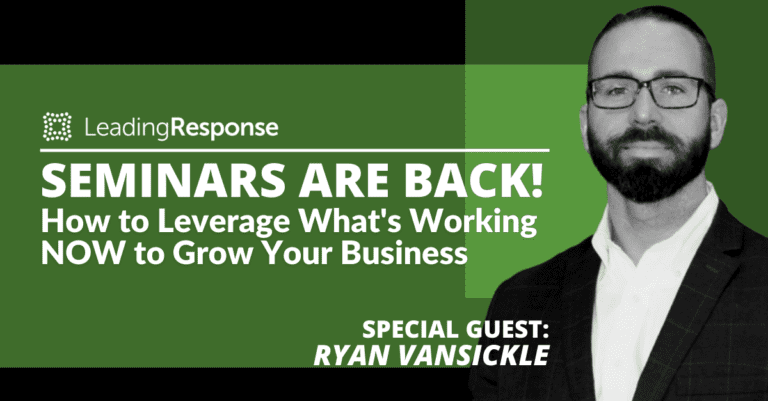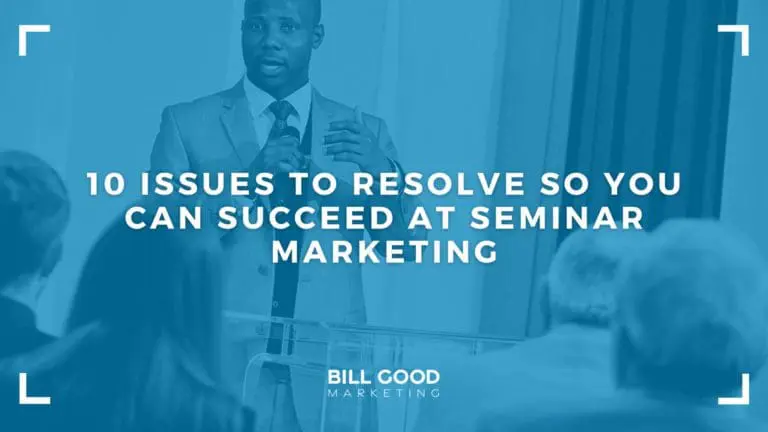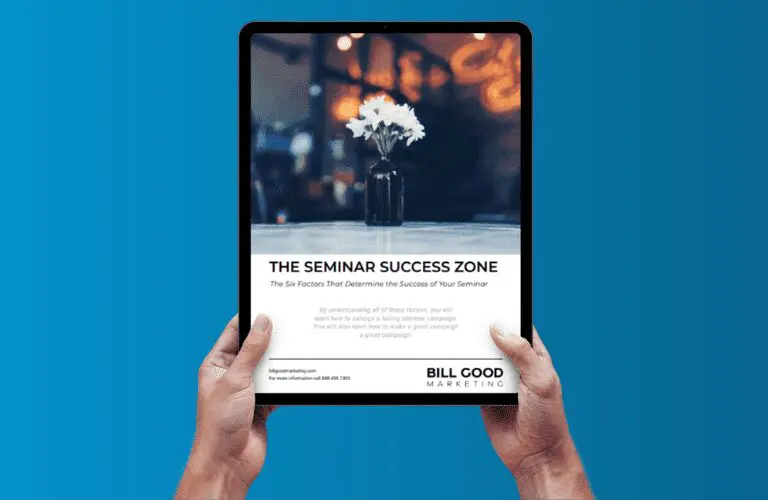There are countless ways to mess up seminar marketing. Of all the possibilities, any one of these can create poor results. Commit two or more of these seminar sins, and you will join the legion of financial advisors who mutter “Seminars don’t work anymore.” Seminars do work, by the way, so long as you get everything right.
Seminar Marketing Mistake #1: Ignoring the Competition
You can have a great seminar idea. But if five other financial professionals in your market have the same great idea on “Annuities” or “Social Security Mistakes” or “Retirement Planning” and if each of them is blasting out 5,000 mailers every month; your conversion rate will likely languish around .2%. Yikes.
It’s the competition.
Ignore what the other people in your market are doing at your peril.
Research your market first.
Call half a dozen of your ideal clients in as many different areas. These are the potential clients your competition is targeting in their marketing campaigns. Ask them to save all the seminar invitations they receive. Even take a box to each home prominently labeled “Seminar Invites for [Your Name].” In a month, go pick up the boxes, bringing a nice thank-you gift of course.
Your boxes will contain the invitations sent out by Leading Response, FTA, LeadJig, or others. You may see invitations created by financial advisors and printed locally. If you see one style that is dominating the market, consider using another so that your invite stands out.
What you are really looking for is one or more invitations being sent month after month. The odds are that invitations sent out repeatedly are the ones that most likely draw your target audience.
It’s time for a little research.
Is it an in-person dinner seminar, or a webinar?
What pain points does the invitation target?
Are there facebook ads? A LinkedIn event? Can you find it on social media? Note this as a single data point.
Next, go to the venue and take a look around.
Certainly do not RSVP for a competitor’s seminar. You would not want someone doing that to you. But there’s certainly nothing wrong with paying a visit to the restaurant or hotel on the night of the event. Walk past the registration table a couple of times. Are people showing up? Or is there a high number of no-shows? My guess is the room will be full.
Now you know what invitation is working in your marketplace. And you know what kind of channels the financial advisor used to promote it.
I’m not saying copy it, but certainly take into account the seminar topic, invitation style, bullet points, audience demographics, location, etc.
We’ve taught for years that it’s easier to re-write than it is to write. We find this to be true for financial advisors who are trying to improve their own marketing efforts.
If you want to have a successful seminar, use the pattern of a previously tested, demonstrably successful seminar.
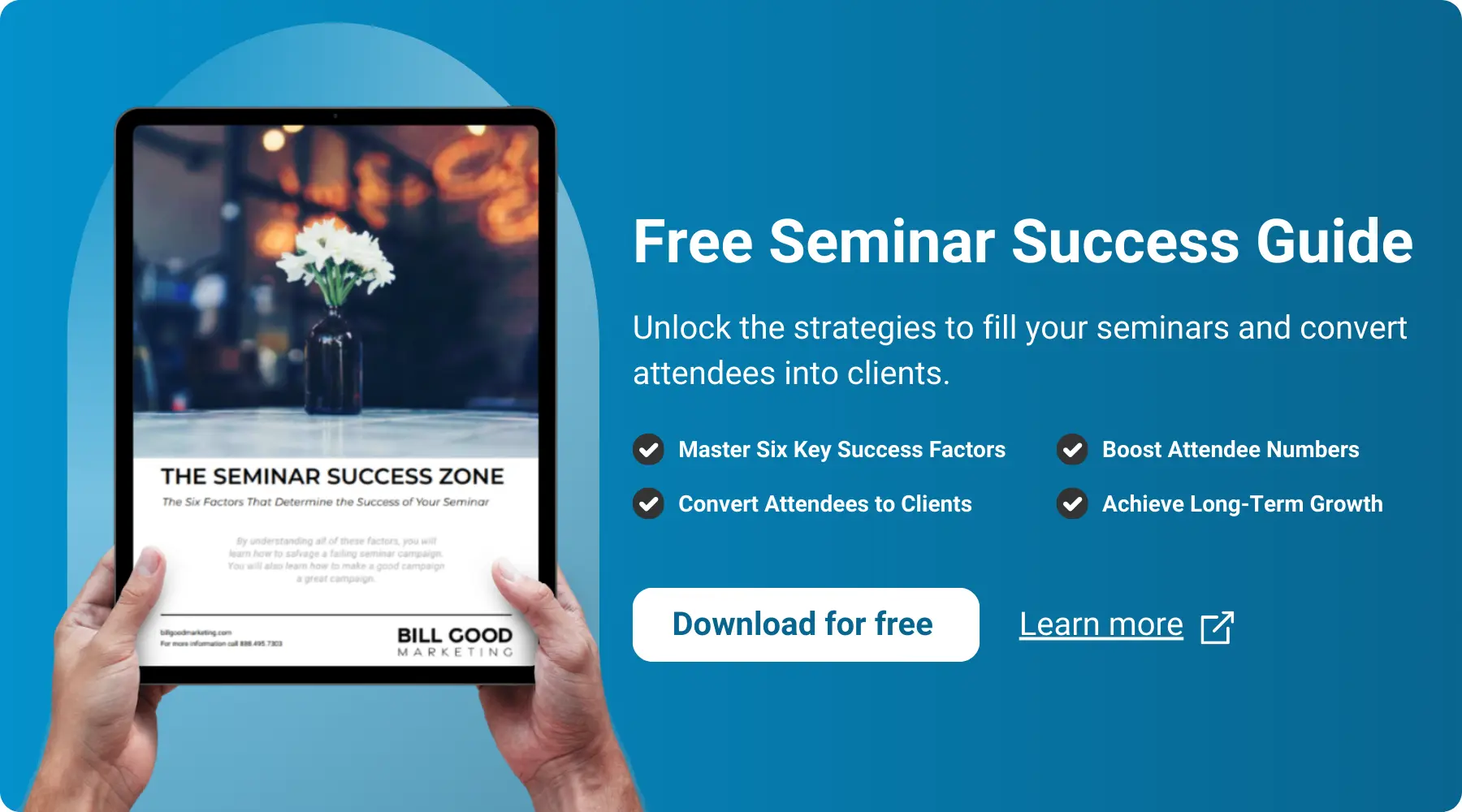
Seminar Marketing Mistake #2: Not Testing
Before committing the troop to a particular seminar idea, let’s test the market.
Your day job, of course, is Financial Advisor. But your other job is direct response marketer. As such, your first commandment is: TEST.
Instead of blasting out 5,000 invitations, I want you to test small. The big direct mail houses may require a 5,000 minimum. So you need to work with a local mail house or printer to test small.
What’s small? Maybe 1,500 or 2,000 invitations.
You need a minimum response rate of 0.7%.
0.8 or 1%, obviously, is better and, by the way, is quite achievable in today’s market. But, you can be extremely profitable at 0.7%, assuming everything else works. (Again, see my “Seminar Success Zone” guidebook.)
Suppose your first mailing fails. You sent out 1,500 invitations and only two couples accept. You spent $1,000, or whatever. Not $5,000. You didn’t blow your whole budget. Round up four or five client couples and invite them to dinner. By surrounding your potential clients with actual clients, you have an excellent chance of getting one new account. You made profit on a failed seminar campaign.
Now, test again. Change the invitation. Or change the list. Or change the location.
Test again.
Keep testing small until you hit 0.7% or better.

Seminar Marketing Mistake #3: A Bad Invitation
If you want a bad invitation, here’s how to create one.
1) Go cheap.
Print a wedding-style invitation on your laser printer.
2) Don’t sell.
I am looking at an invitation right now headlined “Savvy Medicare Planning: What Baby Boomers Need to Know about Medicare Coverage.”
All it offers is “Up-to-date information you need to help you understand the basics of Medicare.”
With that little bit of information would you give up several hours of your time? It doesn’t sell.
A good invitation has a good title. This one actually did. But a good invitation also has three to five bullet points arguing persuasively for the reader to pick up the phone.
A good invitation sells. It does not merely inform.
Seminar Marketing Mistake #4: Bad Location, Bad Location, Bad Location
A few years ago, I was helping a client debug a failing seminar. As I went down my little checklist, I asked, “What is your location?”
He answered, “A quality Holiday Inn.”
I replied, “There is no such thing.”
We moved his location to the best restaurant in town. He sent out another invitation, identical except for the restaurant. Both dinner seminars were booked solid.
Make no mistake: People will come for food. It is the skill of the presenter that converts the so-called “eaters” into prospects. (Financial advisors who complain about “eaters” generally have a poor presentation.)
Bad locations include:
Country clubs, ethnic restaurants (Mexican, Chinese, Thai, etc. etc.), public libraries, community meeting rooms, Moose Lodge (yes, I had to reprimand someone for using one of those), and worst of all, your office.
Don’t get me wrong. You can use your office but not for a public seminar. It’s fine for an educational seminar for clients and their guests. The usual social contract for people you have never met is: you buy dinner and I’ll give you some time. Use your office for a public seminar and I guarantee failure.

Seminar Marketing Mistake #5: Boring or Droning Presentation Style
Let’s say you are served a delicious bowl of soup. A fly lands in it, struggles for a moment, and then drowns.
Of course, you’re done with the soup. Your otherwise perfect meal is ruined.
Your droning speaking style is the fly in the soup. Those eight couples who came to check you out begin mentally checking themselves out within minutes, or even seconds of the drone beginning.
You’ve heard it said, “Seniors have a short attention span.” Rubbish. If you believe that, you have a serious droning problem. I have personally attended many financial advisor seminars, some lasting as long as two hours, and I have seen these same “short attention span seniors” totally engaged, and then even hanging around after the seminar for spirited conversation and even more question-asking.
Let me define professional-grade speaking skills:
You know your material cold and deliver it with passion and conviction.
You can measure the quality of your speaking with a statistic you gather from your post-seminar report card. It’s your appointment request rate.
The question on your report card should read something like, “Yes! I would like an appointment to review my situation.”
Here’s what the results mean:
40% or more of request an appointment = professional-grade presentation skills.
30%-40% = adequate speaking style, but improvement is needed.
20%-30% = boring. No passion or conviction. Probably reading bullet point slides.
Less than 20% = paralyzing experience. Join Toastmasters or get a speaking coach.
First master your content. That means you go “noteless.” OK, for your first few seminars, you can have all the notes you can put on a 3×5 card.
We have developed a procedure to help you master content. We call it “The 25% Solution.” It walks you through a detailed process to help you learn you presentation cold. If you’d like more information about our 25% Solution, you’ll want to talk to Steph about our Seminar Success Zone.
Once you know your content is cold, passion and conviction normally take care of themselves. It’s really quite magic: The key to presentation style is actually content mastery.
Seminar Marketing Mistake #6: Misuse of PowerPoint
I cannot even begin to count the number of seminars wrecked by the misuse of PowerPoint. With PowerPoint misuse, even a good speaker can put an audience down. Those splashes you hear? That’s your qualified prospects pitching forward into their soup.
1) Too many slides (also called “PowerPoint poisoning). Somewhere, someone got the idea that a seminar with 150 slides is a good thing.
Gasp!
Guess what. If you give a seminar on Social Security with nothing more than a flipchart, no one will approach you after you wrap up and say, “I am very disappointed that you didn’t have any slides.”
Slides are visual aids. They are not the show. A good rule of thumb is: Only use a PowerPoint slide if it shows a picture of something that cannot easily be put into words.
And NEVER use bullet point slides. And even worse is reading bullet point slides. No bullet point slides, ever.
For your standard 75-minute presentation, five or six slides should be about right.
2) Leave a slide on the screen when you are talking about something else.
Ironclad rule: When you’re not talking about a slide, turn it off. Press the “B” key. It’s magic. When you’re ready to resume, press the “B” again.
Seminar Success
As you cure an ailing seminar campaign, start with these six factors.
Handle them well, and if you can also sell, you can build a great business from seminar marketing.
If you have any questions on the article or want to know how BGM can help you with your presentation or seminar marketing efforts, feel free to click here and get in contact with one of our consultants!

